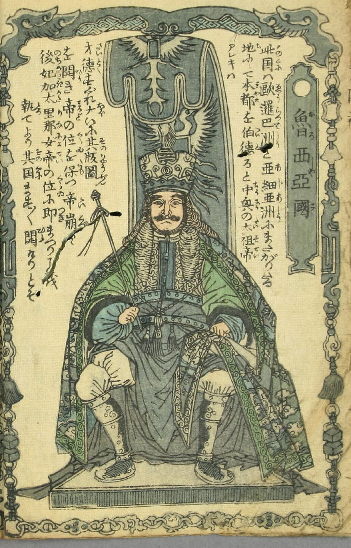Russia for kids
A little light reading: Osana etoki bankoku banashi 童絵解万国噺, roughly "A illustrated guide for children to the nations of the world." By KANAGAKI Robun 仮名垣魯文, with illustrations by UTAGAWA Yoshitora 歌川芳虎. Here's Russia:

I must confess that the text surrounding this delightful image gives me a bit of trouble. [Update! One kanji fixed, see below!]
此国は欧羅巴州と亜細亜州にまたがりたる地にて本都を伯徳ろと中奥中興の太祖帝アレキは才徳すぐれ大いに其版図を開き帝の位を保つ 帝崩[れて?]後妃加太里那女帝の位に即まつり[ごと?]を執てより其国ます/\開けりとぞ
Which is maybe something like:
This country sprawls between Europe and Asia, and the surpassing wisdom and morality of Peter (伯徳ろ) and great emperor and architect of restoration Alexander (アレキ),great founding emperor of central Europe [?]saw the country's domains expand and the imperial system retained. After the collapse of the emperor, his wife Catherine (加太里那) succeeded to the position of empress and took the reins of government, bringing, it is said, still further expansion to the country.
But here are my caveats:
First, I am no expert in Russian history, but as far as I can tell the above is just a jumble of names thrown together without much concern for the actual historical sequence. (Of course, it doesn't help that so many important people in 18th-19th century Russia were named "Peter," "Alexander," or "Catherine" in the first place.)
Second, I'm not at all sure what 中奥の太祖帝 — literally "great founding emperor of the central interior [or throne room]" — is supposed to mean. I have three guesses: (1) Something to do with the Russian imperial system, about which I am clueless; (2) A write-o for 中欧, "central Europe," maybe referring to Alexander I's dukedoms in Finland and Poland; (3) A wildly anachronous reference to the other Alexander, a "great founding emperor" if ever there was one, inspired by the similarities in names. I went with (2) in the translation because it was easiest to write.
Update: Turns out the kanji were actually 中興の太祖帝, not 中奥の太祖帝. 中興 (chūkō) means "restoration" or "revival", and 中興の祖 (literally "ancestor of restoration") is used to refer to a family member credited with engineering or executing a revival in the family fortunes. 中興の太祖帝 simply expands this "family" metaphor to the imperial nation-state, not at all an unusual idea in Meiji Japan. So, pace languagehat's typically informative comment, perhaps this is actually meant to be Alexander II? [Update II: Probably not, see comments. Also, it wasn't quite Meiji Japan yet. The ideas were already percolating, though, and my analysis of the symbolism remains essentially the same.]
Second-and-a-half, I don't know why 伯徳ろ is written like that, with just the ろ on the outside. Perhaps it isn't actually a ろ. It's late and I'm very tired.
Third, the repeated use of 開く here is interesting. I have translated it as "expand" but it could also conceivably mean "develop," and I strongly suspect it had a special meaning as late-Edo political jargon. Unfortunately, I don't know what that might be off the top of my head.
![[No-sword]](http://no-sword.jp/images/site/no-sword_banner.jpg)



Brian:
Peter's son Alexei fits the sequence, though. I would have thought any reference to a great emperor of central Europe would be the Habsburgs, though, and I can't work out the sense with Russia.
And I think you mean "reins of government." Which would be even funnier if it was Catherine II.